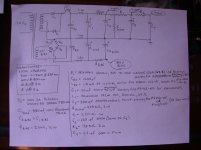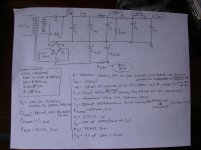Some interesting discussion on rectification http://www.diyaudio.com/forums/digital-source/140538-lossless-sd-card-player-10.html
Isn't it ironic that while solid state/digital folks dream of tube recification, tube amplifiers are getting shottkys?
Isn't it ironic that while solid state/digital folks dream of tube recification, tube amplifiers are getting shottkys?
Wow, i have missed this one. Truly worthwhile of a patent. My subjective appraisal of the SIC diodes is not so high but one can surely use a vacuum diode in this arrangement as well.
A 6AU4GTA is design center rated for 190 mA. of continuous DC. Drawing 200 mA. is well within design maximum. The forward drop is as small as can be gotten in "hollow state" and B+ rise is VERY slow. That should prove quite satisfactory for a PP KT88 monoblock.
In theory, the PIV of the diode connected to the CT doesn't matter. In the real world it does. One fellow connected his Schottky backwards. If it had been low PIV, part failure would have occurred. Instead, he did not get B+.
Last edited:
Here is another PS schematic attempt for the 465-460V B+ version.
I did not show diode snubber caps, but if Fairchild Stealth 8A 1200V diodes are used, bypass with 10 nf 2000V ceramic caps.
hopefully I have everything in the correct place this time...
The Edcor XPWR002 has a completely separate winding for 60V, so I'm assuming bridge rectification is appropriate.
Please comment/critique..
I did not show diode snubber caps, but if Fairchild Stealth 8A 1200V diodes are used, bypass with 10 nf 2000V ceramic caps.
hopefully I have everything in the correct place this time...
The Edcor XPWR002 has a completely separate winding for 60V, so I'm assuming bridge rectification is appropriate.
Please comment/critique..
Attachments
The schematic is still "borked". If Schottky diodes are used everywhere and modest sized caps. are used in the LOW current bias supply, a "hash" filter is needed only for B+. Only 1 RFC gets used.
The CL150 feeds C1. LRF follows C1. CRF connects the junction of LRF and L1 to ground. Other than the values employed, the "hash" filter is a "routine" LC section.
The CL150 feeds C1. LRF follows C1. CRF connects the junction of LRF and L1 to ground. Other than the values employed, the "hash" filter is a "routine" LC section.
I didn't think about having to use Schottky's for the bias too. That is rather expensive. I guess it would do no good to just use them on the B+, as noise would still be introduced through the bias. Hmmm.
The Schottky's for the bias are 100V; they are affordable. They are 43 cents each in qty=1 from DigiKey.
The Schottky's for the bias are 100V; they are affordable. They are 43 cents each in qty=1 from DigiKey.
Yeah I had just checked that, and deleted my post.🙄
Some interesting discussion on rectification http://www.diyaudio.com/forums/digital-source/140538-lossless-sd-card-player-10.html
Isn't it ironic that while solid state/digital folks dream of tube recification, tube amplifiers are getting shottkys?
Quality vacuum rectifiers are getting harder and harder to source. Perforce, we look for SS parts with satisfactory behavior. "Grit" (SiC) high PIV Schottky diodes are a blessing. The ubiquitous, nasty, switching PSUs found in digital electronics have benefited "us tubeheads" in more than 1 way. The high quality electrolytic caps. available trace their origin to that source, along with the high PIV Schottkys.
BTW, it's NOT an accident that many tubed designs known for superior bass performance have SS rectified B+. 😀 Vacuum rectifier "sag" has it's uses in guitar amps, but it (IMO) sucks during music reproduction.
BTW, it's NOT an accident that many tubed designs known for superior bass performance have SS rectified B+.
This is something i have to agree with. I have heard comparable bass only from MR but they are just too much of a pain to constantly use. I guess it comes down to a personal preference of just how important great bass is.
This is what led me to SS rectification for these amps. I wanted to eliminate this drawback to tube ampilification.
I was planning for tube recitification, and regulation on the 12B4 preamp that will supply these poweramps. Does the same "Bass" issue apply to preamps?
I was planning for tube recitification, and regulation on the 12B4 preamp that will supply these poweramps. Does the same "Bass" issue apply to preamps?
Last edited:
Boywonder, The hammond in the schematic is 192M, Did you mean a 193M?
If so, the only remaining issue is that I may not have room for a top mount choke. Any alternative here for a "below the chassis unit"? Cost is not so much an issue as is mounting concerns. If not, I could try to make it work.
Thanks for all this work. That schematic is just what I was looking for!
If so, the only remaining issue is that I may not have room for a top mount choke. Any alternative here for a "below the chassis unit"? Cost is not so much an issue as is mounting concerns. If not, I could try to make it work.
Thanks for all this work. That schematic is just what I was looking for!
Last edited:
Boywonder, The hammond in the schematic is 192M, Did you mean a 193M?
Sorry, 193M is correct.
The below deck mounted chokes (Hammond 15XX series) are going to be marginal as far as henries, current, and max working voltage. The 159T would work; I'll throw it in the model. It's only 2.5 Henries, though.
The B+ ripple for the KT88 increased to approx 55mv.
Last edited:
Repeat, I say repeat, caps. cost less than power magnetics. The "hash" filter, along with the SS diodes, allows the 1st cap. in the CLC filter to be of good size. The Triad C-17X is attractively priced and has good HIPOT characteristics. Use caps. to kill the ripple fundamental and a combination of the "hash" filter and a C-17X to kill the ripple overtones.
Why pay more than necessary to get the performance requisite to the job at hand?
Why pay more than necessary to get the performance requisite to the job at hand?
Sorry, 193M is correct.
The below deck mounted chokes (Hammond 15XX series) are going to be marginal as far as henries, current, and max working voltage. The 159T would work; I'll throw it in the model. It's only 2.5 Henries, though.
The B+ ripple for the KT88 increased to approx 55mv.
Uggh, Thats not good.
Repeat, I say repeat, caps. cost less than power magnetics. The "hash" filter, along with the SS diodes, allows the 1st cap. in the CLC filter to be of good size. The Triad C-17X is attractively priced and has good HIPOT characteristics. Use caps. to kill the ripple fundamental and a combination of the "hash" filter and a C-17X to kill the ripple overtones.
Why pay more than necessary to get the performance requisite to the job at hand?
Addtional caps, or bigger caps, or both? Increasing the size of C1 wouldn't get us back to 10MV ripple I guess?
Can smaller chokes be run in series?
Last edited:
I was planning for tube recitification, and regulation on the 12B4 preamp that will supply these poweramps. Does the same "Bass" issue apply to preamps?
Yes, in my experience. Even with a really good regulator and plenty of capacitance. You pay a bass penalty for using vacuum rectification. I doubt if it's measurable to any extent but if bass is a priority it's either MR or sand.
After serious consideration i've decided that the first octave is just not worth the next ten 🙂
Addtional caps, or bigger caps, or both? Increasing the size of C1 wouldn't get us back to 10MV ripple I guess?
I just tweaked the PSUD model with the 2.5H 300 ma 43 ohm choke:
C1=120uf & C2=330uf....ripple =15mv
C1=120uf & C2=220uf....ripple =25mv
- Home
- Amplifiers
- Tubes / Valves
- Mullard 5-20 KT88 PP blocks!

